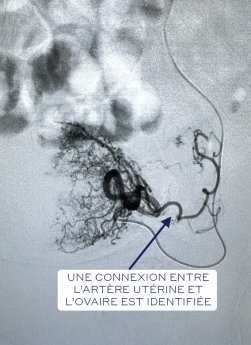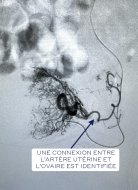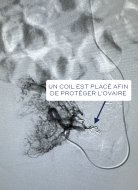Uterine artery embolization for adenomyosis
What does this treatment involve?
What is uterine adenomyosis?
Adenomyosis is a uterine disorder in which endometrial tissue grows into the myometrium, the muscular tissue of the uterine wall. It affects an estimated 11 to 13 percent of the female population, with symptoms mainly occurring in women aged 41 to 45 (1).
In patients with this disorder, the endometrium cells do not grow outside the uterus like they do with endometriosis. They grow only in the uterine wall muscle, without spreading to the nearby organs. The tissue grows gradually, dividing into microcysts and causing the uterus to enlarge, sometimes up to double or triple its usual size.
For one in three women, adenomyosis causes no symptoms and is discovered by chance. In the other cases, it disrupts the menstrual cycle and may cause:
- Menorrhagia: heavy, prolonged menstrual bleeding (> seven days)
- Dysmenorrhea: severe menstrual cramps
- Metrorrhagia: bleeding between periods
- Deep dyspareunia: pain during intercourse
It is diagnosed with imaging exams (pelvic ultrasound and MRI).
How is embolization used to treat uterine adenomyosis?
Uterine artery embolization to treat adenomyosis is a minimally invasive interventional radiology procedure. It offers a painless way to treat the symptoms of adenomyosis.
It consists in blocking the arteries that supply blood to the uterus, using tiny particles. This causes the adenomyosis lesions to shrink, and therefore considerably reduces symptoms.
Adenomyosis embolization can be offered when symptoms worsen and drug-based treatments fail. It is also an alternative to hysterectomy, a surgical procedure to remove the uterus.
The embolization procedure requires the expertise of an experienced interventional radiologist as well as latest-generation equipment.
Learn more about embolization
Learn moreWhat happens during a uterine artery embolization to treat adenomyosis at the American Hospital of Paris?
-
Procedure
Uterine artery embolization to treat adenomyosis is performed at the American Hospital of Paris by one of our interventional radiologists. An anesthesiologist and nurse also remain by the patient’s side throughout the procedure.
The procedure begins with the administration of a local anesthesia at the needle puncture site (either the groin or the wrist). Next, the doctor inserts a small catheter into the artery (femoral artery in the groin, or radial artery in the wrist) and then injects an iodine-based contrast agent. The contrast agent lets the doctor track the progression of the catheter as he or she guides it inside the arteries under X-ray guidance.
Once the catheter is correctly positioned in the uterine arteries, the doctor performs the embolization by injecting biocompatible embolic microbeads that block the blood vessels. This cuts off the blood supply to the adenomyosis, causing the tissue to die without posing a risk to the healthy uterine tissue.
The interventional radiologist then removes the catheter and places a compression bandage over the puncture site. The procedure is pain-free and scar-free.
-
Duration of the procedure
The adenomyosis embolization procedure lasts 45 minutes to one hour on average.
-
Postoperative follow-up
After the procedure, you will be hospitalized for 24 to 48 hours. You might feel pain in your lower abdomen for a few hours, which can be easily relieved with analgesic medication. You can resume walking immediately if the catheter was inserted at the wrist, or after four hours if it was inserted at the groin.
Once home, you may feel mild pain that persists for several days. This can be relieved with the appropriate treatment.
It is also normal to feel extreme fatigue after this type of procedure. We recommend a two-week leave from work.
In all cases, the recovery time following an adenomyosis embolization procedure is much quicker than with surgery.
It should also be noted that your adenomyosis symptoms will improve gradually. Some pain and bleeding may persist for the first two or three menstrual cycles following the procedure.
Our medical team is available 24/7 via a hotline to answer any questions you may have. Our Emergency Care Center is also open 24/7 if you experience any abnormal symptoms.
-
Cost and reimbursement
Uterine artery embolization to treat adenomyosis is reimbursed by Assurance Maladie, the French national health insurance, and by private supplemental health insurers.
In accordance with Article 53 of the French code of conduct for medical professionals, physician fees must be determined with tact and moderation and fall within the national average.
You will benefit from the medical expertise and safety of a bona fide hospital and receive exclusive care delivered by our anesthesiology team and paramedical staff, all in a pleasant and comfortable environment.
How can I prepare for uterine adenomyosis embolization?
To prepare for your procedure at the American Hospital of Paris, for your first consultation with the interventional radiologist, please follow the guidelines below:
- Bring your blood workup and ultrasound and/or MRI results the first time you see the interventional radiologist
- Schedule a preoperative anesthesia consultation in the month prior to the procedure
- Inform us of any medications you are currently taking
- Do not eat or drink after midnight the night before the procedure

What are the outcomes of uterine adenomyosis embolization?
The most recent studies on uterine artery embolization to treat adenomyosis show that it is a promising treatment for the associated symptoms (1):
- 75 percent of patients reported experiencing overall relief from symptoms (based on 15 studies on 511 women with adenomyosis) (2)
- The postoperative MRI often shows a decrease in uterine size and in the areas treated during the procedure. (3)
What are the side effects of uterine adenomyosis embolization?
Uterine artery embolization to treat adenomyosis is a minimally invasive procedure. The risk of complications is therefore very low.
There are risks relating to the catheter (blood vessel damage, bleeding or bruising at the insertion site). However, these risks are drastically lowered when the procedure is performed by an experienced practitioner.
In certain patients, there is also a risk of allergy to the iodine-based contrast dye. At the American Hospital of Paris, you will be monitored throughout the procedure to prevent any adverse reactions.
Lastly, a post-embolization syndrome may appear in some cases. You may have a low fever and feel unwell for five to seven days.
Key figures
-
48.7%
The number of women with deep endometriosis who are also diagnosed with adenomyosis.
-
42 TO 60 %
The number of women with adenomyosis who suffer from menorrhagia (heavy menstrual bleeding).
Sources & crédits
1 . Adenomyosis: Epidemiology, Risk Factors, Clinical Phenotype and Surgical and Interventional Alternatives to Hysterectomy
F. A. Taran, E. A. Stewart, and S. Brucker
https://www.ncbi.nlm.nih.gov/pmc/articles/PMC3859152/
2 Uterine Artery Embolization for Adenomyosis,
Theresa M.Caridi MD, FSIR
Journal of Vascular and Interventional Radiology,
https://www.sciencedirect.com/science/article/abs/pii/S1089251621000044
3. Uterine Artery Embolization for the Treatment of Adenomyosis: A Review
Martin Popovic BSc, StefanPuchner MD, Dominik Berzaczy MD, Johannes Lammer MD, Robert A.Bucek MD
Journal of Vascular and Interventional Radiology,
https://www.sciencedirect.com/science/article/pii/S1051044311007676
4. Uterine Artery Embolization for Adenomyosis: Percentage of Necrosis Predicts Midterm Clinical Recurrence
Sohi H. Bae, Man Deuk Kim, Gyoung Min Kim, Shin Jae Lee, Sung Il Park, Jong Yun Won, Do Yun Lee,
Journal of Vascular and Interventional Radiology,
https://www.sciencedirect.com/science/article/pii/S1051044315004376



